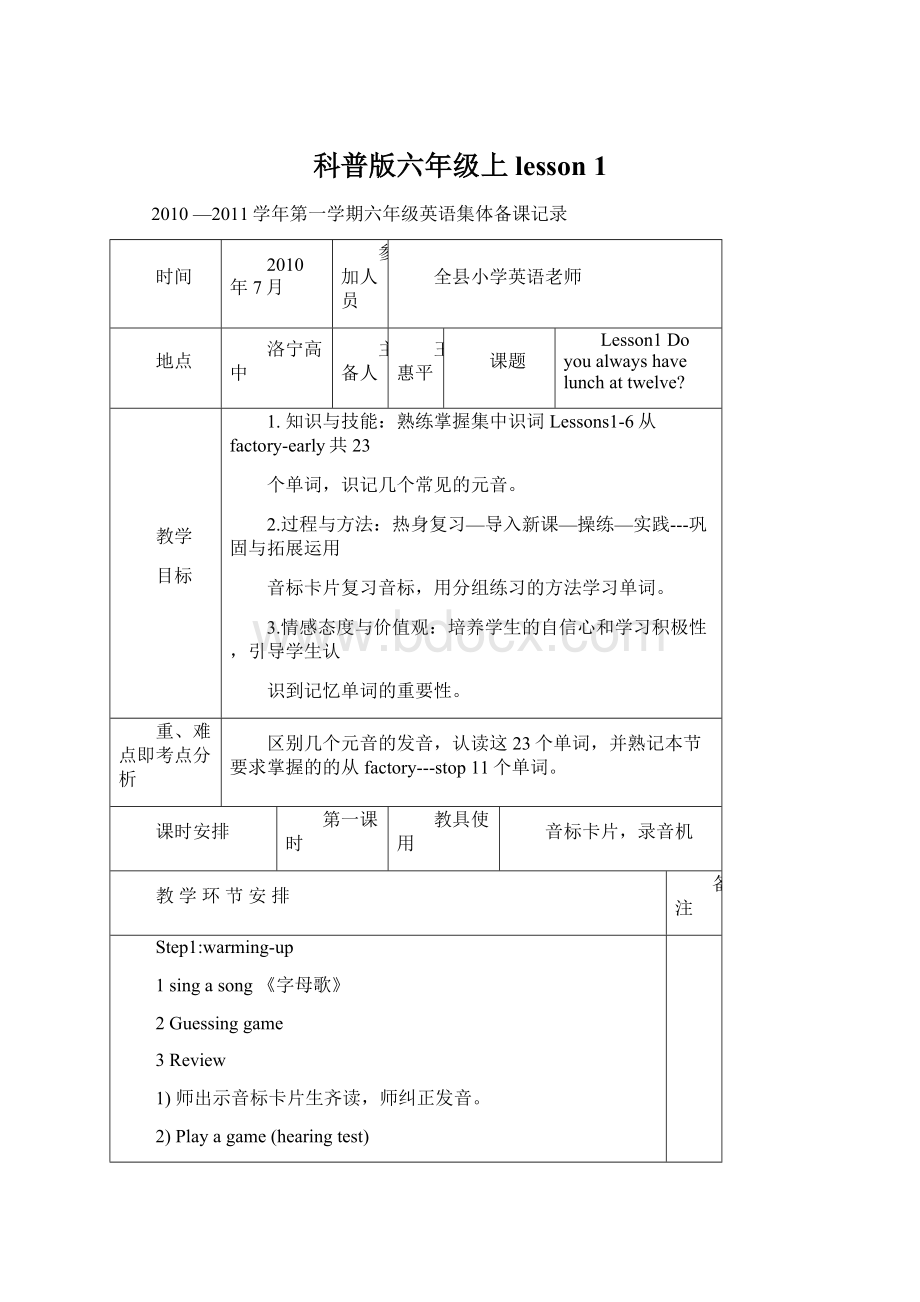科普版六年级上lesson 1Word格式文档下载.docx
《科普版六年级上lesson 1Word格式文档下载.docx》由会员分享,可在线阅读,更多相关《科普版六年级上lesson 1Word格式文档下载.docx(15页珍藏版)》请在冰豆网上搜索。

2Guessinggame
3Review
1)师出示音标卡片生齐读,师纠正发音。
2)Playagame(hearingtest)
师读某个音标,生闭眼听并从音标卡片中找出所听到的音标,正确者得到掌声,不正确的继续猜,直到猜对为止。
Step2Presentation
1师板书单词,按所含元音的不同分组,这23个单词共分8组,如:
factory/fæ
ktəri/工厂
Travel/træ
vl/旅行
Than/δæ
n/比
Ant/æ
nt/蚂蚁
这一组音标中都含有元音/æ
/,让学生根据音标读出这些单词,师纠正发音并领读。
2师说一句话,用上所学单词,如:
Myfatherhasafactory.
ThereisatoyfactoryinLuoning,itsnameiszhongkuo.还可以让学生用所学单词组词,如:
师说汉语:
鞋厂,生译英语shoefactory每个单词都可以用这种方法学习,让学生在句子和词组中感受单词的意思,印象会更深刻
3在生会读,并认识中文的基础上,师遮住中文,让生站起来读英文并说出中文意思。
4每一组都可以用同样的方法来学习。
Step3:
Drills
1师放录音,生听录音并跟读。
2让生齐读、分组读,自由读。
3让生自己遮住中文读单词并说出中文,说不出的可以看书。
4让生两人一组互相问答记忆,不会的由提问人提醒,以便相互检查,相互促进,提高记忆速度。
5师擦掉黑板上的中文,由生上讲台来看单词填写中文。
6师说中文,生齐读英文,或者换作男生说中文,女生读单词,然后女生说中文,男生读单词。
Step4Practise
1Playaguessinggame师读一个单词,生齐说出中文,然后挑一名学生照这样读单词,其他学生说出中文,练几个以
后,换一名学生读单词另一名学生说中文,答对的给掌声,答错的罚其读单词。
2按小组进行记单词比赛,每组挑出实力最强的同学与对应
组PK,老师将每组的比赛得分写在黑板上
Step5Consolidation
师在黑板上竖着写出一些易混淆的单词,并在其右边写出他们的中文,让生连线,要求正确率95%以上。
如:
Wrong工作日
Worried早的
Weekday在…以前
World错误的
Early东方,东部
Earth担心的
East开始
Begin世界
Before地球
板书设计
Lesson1Doyoualwayshavelunchattwelve?
/æ
/factory/fæ
ktəri///month/mnθ/
vl/suddenly/sdnli/
Than/δæ
n/worried/wrid/
nt//i:
/east/i:
st/
/e/never/nevə/weekday/wi:
kdei/
Anyone/eniwn/agree/ə’gri:
/
/i/begin/bigin//כ:
/always/כ:
weiz/
Live/liv/before/bifכ:
Window/windəu//ə:
/world/wə:
ld/
/כ/wrong/rכŋ//year/jə:
Stop/stכp//earth/ə:
θ/
early/ə:
li/
作
业
布
置
●1、听磁带20分钟,并读本课单词十遍。
●2、抄写一遍英文,默写出对应的中文,并记会写会单词从factory---stop.(11个单词)
重
难
点
及
考
巩
固
性
练
习
一、从每组单词中选出一个划线部分发音与众不同的。
1、()AfactoryBtravelCthanDanyone
2、()AbeginBliveCbikeDwindow
3()AstopBmonthCsuddenlyDworried
4、()AeastBweekdayCagreeDbefore
二、英汉互译
thanalwayssuddenly
开始月份任何人
绝不工作日同意
stopeastworld
20—20学年第学期年级学科集体备课记录
主持人:
1知识与技能:
学习Let’slearn,熟练掌握本课的主题句:
Doyoualwayshavebreakfastatseven?
Whatdoyouhaveforbreakfast?
Iusuallyhavemilkandbread.能用其他词组来做替换练习,会运用at+数字来表示时间。
唱会歌曲《Themusicroom》
热身复习—导入新课—操练—实践—巩固和拓展
讲练结合,通过自制钟表进行操练
通过对话,培养学生的时间观念,,引导学生热爱生活。
熟练掌握时间的表达方法,并熟练掌握一般现在时主语非单三时的句子结构。
第二课时
录音机、自制词卡
1复习第一课的单词,及时间的表达如:
attwelveateleventhirtyatsixfifteen
2复习上一课时的对话,让学生两人一组上台表演对话。
1、A)师讲解一般现在时和现在进行时的区别。
一般现在时:
表示经常性、习惯性的动作。
现在进行时:
表示正在进行的动作。
Ihavelunchattwelveeveryday.(一般现在时)
Iamhavinglunchnow.(现在进行时)
B)让生了解一般现在时常与频度状语连用,常用的频度副词有:
always(表示100%的频度)usually(80%--90%)
often(50%--70%)sometimes(30%--50%)
Seldom(10%--20%)never(0%)
另外还有,如:
everyday(morningweekmonth)
everytwodays=everyotherday(每两天或每隔一天)
everythreehours(weeksmonthsyears)
onceaday(weekmonthyear)
twiceadaythreetimesayear
onSundayonSaturdayafternoon等
C)一般现在时陈述句,一般疑问句,特殊疑问句(主语非单三)
举例说明:
Iusuallyhavelunchattwelve.(陈述句)
Doyouusuallyhavelunchattwelve?
(一般疑问句)
Whattimedoyouusuallyhavelunch?
(特殊疑问句)
师总结句子结构:
一般疑问句:
Do+主语+动词原型+其他成分
特殊疑问句:
疑问词+do+主语+动词原型+其他成分
常用的疑问词有:
where(对地点提问)whattime/when(时间)how(对方式和程度状语提问)
2通过师生对话导入新课:
T:
Doyoualwayshavelunchattwelve?
S:
Yes,Ido./No,Idon’t/Iusuallyhavelunchat……
Whatdoyouhaveforlunch?
Rice/noodles
Step3Drills
A)利用书中插图,组织学生分组操练,用词组havelunch
attwelvehavesupperatsix等进行替换练习。
B)轻松一下,教学生唱歌曲《themusicroom》
Step4Practise
1Playagame
TeachSshowtoplaythegame
Onestudentpicksupacardofthephrase:
havesupperatsix/havelunchateleventhirty/dohomeworkatseven/watchTVateight/gotobedatninethirty
thestudentmakeanewsentence,thenletotherstudentplaythegame,atlastteachershowsthecardsontheblackboard,letallstudentsmakesentences.
2telephonegame(师可以先做示范)
PlayatelephonegameuseP5let’spractice,letastudentcalltheotherstudentanddialogue:
Whatareyoudoing?
I’mhavinglunch/supper
Doyouusuallyhavelunch/supperattwelve/seven?
Yes,Ido/No,Idon’t.Iusuallyhavelunchateleventhirty.
Step5ConsolidationandExtension
1、Letstudentsuseotherphrasesmakesentences
2、Singthesongtogether
●听磁带20分钟,并读本课let’slearn十遍,做练习册七题
按要求完成句子
1Wealwaysgetupatsix(对划线部分进行提问)
?
2Theyusuallygotoshoolbybus(对划线部分进行提问)
3Ihavebreakfastatsixthirtyeveryday(变成一般疑问句)
4IoftenwatchTVathome(对划线部分进行提问)
?
5Maryandhermothergoshoppingonsunday(变成一般疑问句)
Lesson1Doyoualwayshavelunchattwelve?
Doyouusuallyhavebreakfastatseven?
Yes,Ido
Iusuallyhavemilkandbread
havebreakfasthavesupper
at12:
00at6:
00
noodlesrice
(Let’stalk)
熟练掌握本课对话中的主要句型,知道时间的表达法,能熟读对话并能用对话中的句型进行交际。
热身复习—导入新课—操练—巩固拓展---应用
运用自制教具进行对话教学及操练
通过对话,培养学生的时间观念,,引导学生科学的安排自己的生活。
熟练掌握时间的表达方法,并学会一般现在时主语非单三时的句子结构。
第三课时
录音机、自制钟表
1Playagame(数字游戏)叫两生上台,分别说两个一百以内的数字(用英文),看谁能快速说出两数之和。
2Review
1)复习第一课的单词:
alwaysusuallyriceearly及时间的表达如:
twelveeleventhirtysixfifteen
Step2
1(师拨动模型表)T:
Whattimeisit?
It’stwelve
It’stimeforlunch.
(师再拨表针)Whattimeisit?
It’ssix
It’stimeforsupper.
2T:
Now,Pleaseturntopage1,lookatthetalkandlistentothetape.(听完后)
let’safterit.
Whocantranslateit?
师总结:
at+数字表示在几点
It’stimefor+名词表示该……了
生自己造句,如:
It’stimeforschoolIt’stimeforsupper……
1将对话分成两段,前六行为第一段,余下的为第二段,师先逐段领读。
2板书关键词,让生根据黑板上的关键词进行分段对话,如:
男女生分角色对话,前后排分角色对话等。
3分段操练几遍以后,连起来进行对话操练。
4熟练以后,叫几组同学起来进行对话。
让生运用所学对话进行拓展,。
Now,Let’slookattheclock,Whattimeisit?
(师将表针拨到六点半)
It’ssixthirty.
Oh,It’stimeforbreakfast.
Yes.
Doyoualwayshavebreakfastatsixthirty?
Yes,Ido.Whataboutyou?
Iusuallyhavebreakfastatseven,SometimesIhavebreakfastatsixthirty.
Whatdoyouusuallyhaveforbreakfast.
Breadandmilk
1让生根据以上的师生对话进行自由对话练习。
2挑几名同学上台表演自由对话
●听磁带20分钟,读本课talk十遍,并将课堂上自由对话内容书写一遍。
根据课文内容选词填空
1Whattime(is/its)it.
2it’stime(to/for)supper.
3(Do/Are)youalwayshavelunchattwelve?
4Iusually(has/have)supper(at/on)
Seven
5it’stimefor(school/gotoschool)
Lesson1Doyoualwayshavelunchattwelve?
It’stimeforlunch
Doyoualwayshavelunchattwelve?
Yes,Ido.Whataboutyou、
Iusuallyhavelunchateleventhirty.
SometimesIhavelunchattwelve
Whatdoyouusuallyhaveforlunch?
Rice
(read)
学习Read,熟练掌握Read中的词组,能看关键词复述课文,能根据课文内容回答问题。
热身,复习—导入新课—操练—巩固和拓展—应用
图文结合,讲解与练习相结合
通过课文,培养学生做事情要认真、细心。
熟练掌握文中的词组,并能熟读课文,复述课文,能运用文中句式造句
第四课时
Step1Warming-up
1Singasong《themusicroom》
2ReviewthewordsofLesson1.
3Reviewthedialogueof“let’stalk”,letstudentssaythedialogueusethecards:
havebreakfast/havelunch/atseven/attwelve……
1TeacherintroducethestoryinChinese.(不需要讲的太详细,只简单提示一下)
2Studentslistentothetapeandtranslatethestory.
3Teacherreadthestoryandwritethephrasesontheblackboard:
wakeup/domorningexercises/washface/makebreakfast/athome/runtoschool.Teacherteachandtranslatethephrases.letstudentsmakesentencesusethephrases.
4Studentslookatthephrasesandlistentotapeagain
Step3Drill
1Studentsreadthetextafterteacher.
2Studentreadthetexttogether.
3Studentsreadthetextbythemselves.
4letSssaythestoryusethekeywordsandphrases
5Teacherask,Ssanswerthequestions:
1)Isitearlyinthemorning?
WhattimeisitbyJohn’sclock?
2)DoesJohndomorningexerciseseveryday?
3)Whattimedoeshismothermakebreakfast?
Issheinthekitchennow?
4)WhattimedoesJohn’sfathertakehimtoschool?
CanhetakeJohntoschooltoday?
5)Isthereanyoneintheschool?
Ishetooearly?
Whattimeisitnow?
6)What’swrongwithJohn’sclock?
1Letstudentmakesentences,examples:
1)Havenotimeto+vt
Havenotimefor+n
Wehavenotimetohavelunch
Wehavenotimeforlunch……
2)there’ssomethingwrongwithsth.
Sth.doesn’twork
There’ssomethingwrongwithmycar.
Mycardoesn’twork.
3)Thereisn’tanyoneintheschool=Thereisnobodyintheschool
4)either也,too也
too用于肯定句中,either用于否定和疑问句中。
Ilikesing,Ilikedancetoo.
Idon’tlikesing,Idon’tlikedance,either.
Step5Consolidation
1TeachersaysChinese,studentssayEnglish.(尽量让学生用英语自